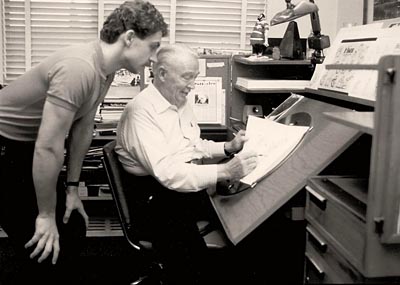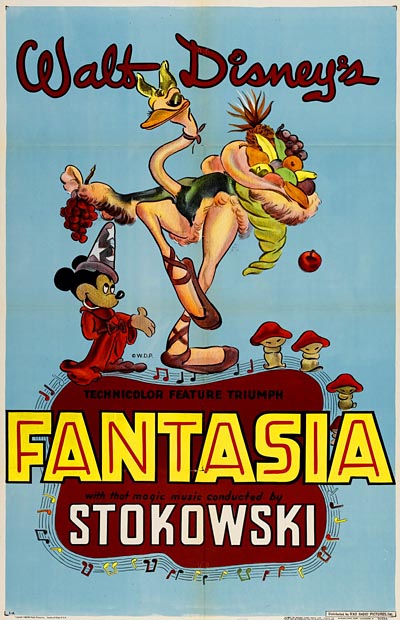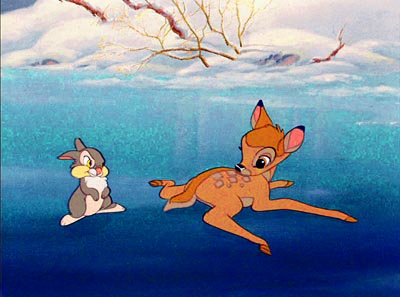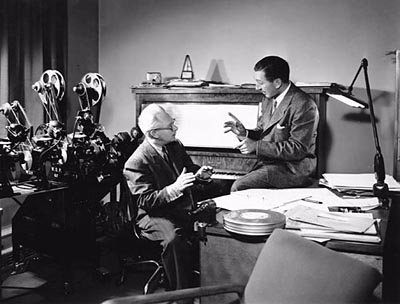
An’ the dawn comes up like thunder outer China crast the bay!
There may be no way of drawing a comparison, emotionally or in magnitude, between a spectacle of nature as painted in Mr. Kipling’s lines and Mickey Mouse’s performance in glorious black and white, as he bounced through Steamboat Willie, the first animated cartoon with sound. But, one thing is certain- Mickey and his music have had the greater impact world wide.
The sunrise, inspiring as it is, is for now- Mickey and his music is for days and days into time.
Steamboat Willie, the third Mickey Mouse short to be made, was the first to be exhibited. The opening was on November 18, 1928, at the “Colony” theater in New York City.
The day Mickey started bouncing to the sound of music, the entertainment curtain opened wider and wider and the animated picture took on a new and exciting dimension. The shorts pictures to follow were musically constructed to the beat- all carefully planned out in entirety by the director and his musician, cozily housed in their “music room”, before animation was even begun. Characters walked to a beat- ran to a beat- re-acted on the beat- punched one another to the beat- it was beat, beat, beat, and as people in the theater watched and listened, the unconsciously tapped their feet in sync. In the cartoon, sight and sound had joined forces and new horizons beckoned.

Fantasia, far ahead of its time and, to this day, still way out front, could well be considered the greatest marriage of the animated picture and music. In it, the creative relationship of one to the other is unsurpassed, offering the audience a memorable experience in the fanciful and the dramatic.
Gradually we began to look to music to further enhance our pictures, rather than to “control” them. We pulled away from the beat domination. With Snow White the animated picture became an exciting competitor to the live action film. Linear drawn characters, moving in the imaginative world of Walt Disney animation, pushed to the front, right as Stromboli would say, “In de pooblic’s eye”, and with those drawings came a new and expressive use of music in our films, giving support and punctuation to moods, locales and action. Music became a vital part of our story, adding new emotional pleasures and meaning to our pictures.
And then came those wonderful moments when musical instruments interpreted the personalities and the characters “did speak through music”.

In Peter and the Wolf the bassoon, you remember, was the personality and voice of the “Grandfather”. The oboe, melancholy in its sound, was Sascha’s friend the “Duck”, The flute, with its pitch and note capabilities, was the nervous, explosive little “Sascha”. Each of the other characters, too, found his identity in an instrument and melody.
In Peter and the Wolf, so closely were the intruments and music related to the characters’ personalities and actions that all musical notes in the score, where relevant to the scene, were copied onto the exposure sheets in proper place, often in a diagonal way that would suggest the “up-scale” or “down-scale” movement of the musical phrase, giving a positive “dialogue” inflection and interpretation.
This demanded that the animator “read” the musical phrases noted on his exposure sheet as he would “read” dialogue phrases, looking and listening for accents and moods which would inspire the attitudes and timing in his characters’ actions. We seldom give thought to music “talking”, but it does and it can be as expressive in any given mood or action as dialogue can be. Music, like dialogue, has flow and accents which must be “caught” in our animated action. Let’s think back on Dance of the Hours, on the Rite of Spring, on the Sorcerer’s Apprentice and the rest of Fantasia and remind ourselves of just how important and how delightful musical sync can be.
Of course, songs and dance music written for a picture, must be pre-scored. But the mood music, always a very important part of our entertainment, is written after the picture has been well developed, and in most cases, after “rough animation” is done and okayed. For the musician, it becomes a challenging work. He often has to catch, musically, emotional outbursts and actions our characters might display. The musician frequently has to make a frame by frame study of an action in order to give it the desired musical support. For instance: A character is in a running action, trips and has difficulty getting back into stride. This presents the muscian with the problem of working out a musical pattern that will give accent to the “trip” and musically “illustrate” the effort the runner makes, through frantic off-balance steps, to get back into stride. It might be called “a little stumbling music”, and in writing it, the musician would be checking and studying the animated action frame by frame.

A wonderful exercise in writing to the animated action was experienced by the musician in the business of Thumper getting Bambi onto the ice and the confusion and maneuvering that followwed, ending up with the two of them in the music.
In duscussing the musician’s role, Buddy Baker answered the question this way…
A note every frame? Well, we don’t go that far but we do get into two frame notes, and that’s pretty fast. That’s about as fast as an orchestra can play. We have to make an analysis of the story and animation, break it down in every way possible, select the mood of the music that is necessary, get the rough andimation and start laying out our music to match.
One thing Buddy didn’t mention in his discussion was the need to work and re-work music to get the desired result- just as we work and re-work story and animation. It always takes the team effort to get a final result on the screen.
Our pictures demand music with mood and vitality. Once written, we rely on good arranging and full orchestration to achieve a maximum effect. But, music is emotion, isn’t it? It reflects spirit and mind; so there are those times and situations when the strength and joy of our music finds its outlet in a simple form, which by comparison to that of dramatic scope and splendor, would be like a one finger exercise on the piano.
Music can interpret any visual happening. The sweep and grandeur of the countryside transcends reality when sounds of music are part of the picture. And the fury of a thunderstorm over the canyon, or that which was Maleficent’s, reaches a visual crescendo when supported by interpretive music. The humor and charm so often seen in the personality and movements of a bird, an animal or a human is two fold when supported by complementary music. As noted, in Peter and the Wolf the choice of the instrument, as well as the musical theme was important to the development of a given character on the screen. It was a strong identification of that character’s personality. It was as much a part of him as were his physical make-up and actions.

It was so with the Araucuan Bird, a South American native that we used in several pictures. He had a very simple and exciting musical theme- very repetitious! It was “go-go-go!” and that was the Araucuan- loose, free and unpredictable! In contrast, the tortoise in Tortoise and the Hare had a theme that instantly said, “Slow- persistent- determined”. In each of these themes, like many others, the animator found a “spirit” to use in their animation.
This is true in all we do, we try to be on target. The crisp action and charm of a bird, a small animal or a child, as suggested a moment ago, could hardly find interpretation in the hands of a tuba. This then, is the musician’s problem- to write music befitting the character, his moods and his actions, and then to find the most descriptive instrument to play it on.
As animators, we should be ever aware of music and its value to us. We remember sitting in a group studying the pantomimist’s acting routine. It was very simple- opening and closing a door- happily walking across the room- sitting down in a chair- being pricked by a pin, looking at it and tossing it away and then sitting down again, relieved. Without music, the routine was entertaining, clear in thought and acton- nothing wanting, but…
The action was repeated to music, the music being a very simple tune played on a piano. The pantomimed action got a boost as interpretive musical phrases gave emphasis to actions such as the opening and closing of the door- the happy move across the room- the reaction to the pin prick- the viewing of the pin and tossing it away- then happily sitting down. Music just made a goood act better!
Oliver Wallace and Walt Disney
Music, has always given an added quality to our “sound effects” by “rounding” them out, taking off the sharp edges and “sweetening” them to give added dimension and resonance. Often, the music carries the whole “sound effect” beautifully. It was always a treat to hear Ollie Wallace, one of our musicians of a few years back tell of his early days at the old movie theater organ, blasting out, spontaneously, mood music for the silent film flickering up on the screen above him. If the picture needed chase music- Ollie provided it. If it needed a love theme- Ollie gave it the old Hearts and Flowers. If it needed the fury of a cowboy and Indian fight with gunfire- Ollie let ’em have it, Bang! Bang! and when the villain was sneaking up behind the heroine- Ollie sneakeed in some sneak music, and the audience yelled “Look behind you!” Through the whole silent movie no frame or act got by without Ollie’s musical support.
Perhaps today, Ollie’s show would be considered crude, but it surely is a graphic illustration of the value and need of music in our entertainment.
Think about it: Sight and Sound… so complementary, one to the other!
Eric Larson
October 20th, 1981
This posting is part of a series of articles comprising an online exhibit entitled Theory.
FEATURED EXHIBIT
Music shares an indescribable magic with animation. It’s hard to describe in words exactly why certain walk cycles or pantomime gags are so wonderful. Music is a source of non-verbal delight as well. The rhythms and pacing of cartoons often mirror the construction of popular music with a statement of theme followed by variations, culminating in a restatement of the theme and a big finish. If you think about it, the best cartoons are inseparable from music. Adventures in Music explores the wide world of music with an eye to revealing the relationships between music and creativity.































